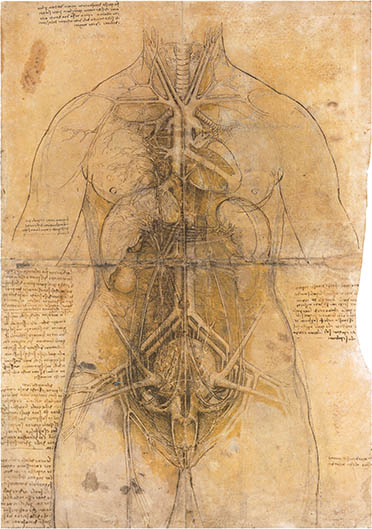Vitruvian Man, ca.1492. Courtesy Luc Viatour1
46
Leonardo’s Notebooks
Vasari, commenting on the Mona Lisa, stated that “after he had lingered over it four years, [he] left it unfinished..,” and this statement could well apply to all of Leonardo’s rather wide-ranging endeavors. He started projects and abandoned them only to take them up again later – sometimes years later. His anatomy studies were no exception.
The earliest studies recorded in his notebooks were of topographical anatomy carried out in Milan starting around 1485. A decade later he returned to the subject, having access to cadavers at the Ospedale di Santa Maria Nuovain in Florence, where it appears he collaborated with the young anatomist Marcantonio della Torre.2 His final period, at the Ospedale di Santo Spirito in Rome, started in 1513 only to be cut short by papal decree three years later.
Fetus and womb, ca.1510, Courtesy Luc Viatour1
Leonardo was an Aristotelian, and later a Galenist, and the accuracy of his anatomical sketches vary widely. Some are clearly direct observations: e. g., he was the first to draw the coronary arteries. Others were based on animal anatomy (especially cows) and still others were entirely fantasy, perhaps based on space aliens.
Nevertheless his illustrations were much better than anything else at the time. Unlike contemporary work by Ketham, or even Berengario, Leonardo’s subjects were drawn in a spare, mechanical, but three dimensional style, without artistic flourish. He treated anatomy no differently than, say, a helicopter, siege weapon or water pump. They were the best anatomical illustrations that no one ever saw.
Female genito-urinary system. ca. 1510
After Leonardos death in 1519 the notebooks were inherited by his student Francesco Melzi, who closely guarded them for the rest of his life. Melzi’s heirs, however, had less regard for the work and dispersed of it in bits and pieces.3 Most of the anatomical drawings, by rather obscure provenance, found their way into the Royal Library at Windsor where they sat, largely neglected. Although there was a renewed interest in the notebooks by the end of the eighteenth century, it wasn’t until the early twentieth century that facsimiles became widely available.4 A little too late to influence anatomical illustration.
1. These excellent photos were taken by Luc Viatour from the Leonardo da Vinci–The European Genius exhibition at the Basilique de Koekelberg in September 2007. More photos of the exhibition, including one of Mary Magdalene, my favorite almost-Leonardo painting, are on his site.
2. According to Vasari, Leonardo, possibly with della Torre, intended to write a treatise on anatomy and many of Leonardos notes allude to ideas for book. Like most of his plans, however, this never happened.
3. There are some 7000 extant notebook leaves and fragments scattered among various libraries and museums. It is thought that this represents about a quarter of Leonardo’s total production.
4. The first, although not very complete, facsimile of the anatomical drawings was: Sabachnikoff, T, et. al. I Manoscritti di Leonardo da Vinci della reale biblioteca di Windsor. Dell'Anatomia. Fogli A. Turin: Roux e Viarengo, 1898. The first official survey of the Windsor materials was published as: Clark, Kenneth. A Catalog of the Drawings of Leonardo da Vinci in the Collection of His Majesty the King at Windsor Castle, 2 vol. Cambridge: 1935, or New York: Macmillan, 1935. This title has been reprinted several times, most recently by Phaidon. The now standard reference on Leonardo’s anatomical notebooks is: Keele, K. D. Corpus of the Anatomical Works in the Collection of her Majesty the Queen, 3 vol. New York: Johnson, 1979–1981.
21 Nov 2009 ‧ Anatomicae


